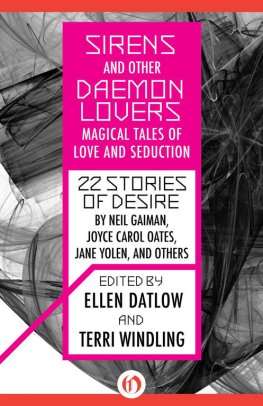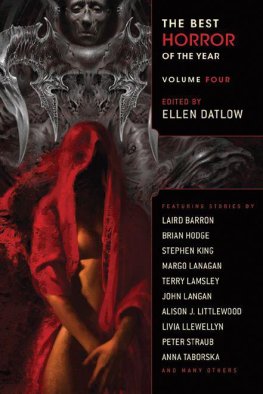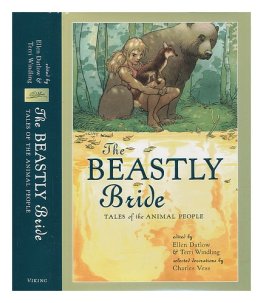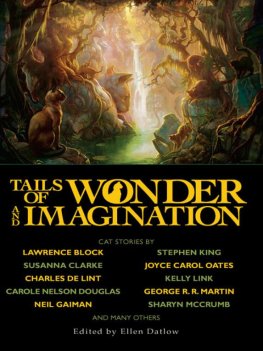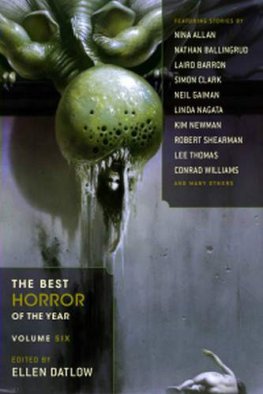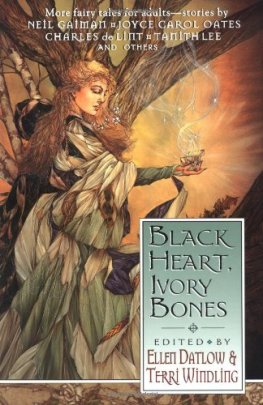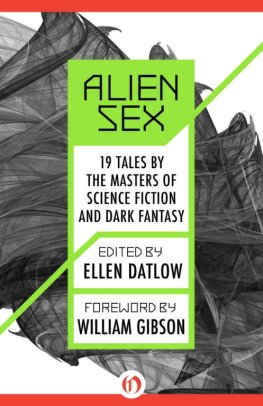SIRENS AND OTHER DAEMON LOVERS
Edited by
Ellen Datlow and Terri Windling
Thanks are due to Tappan King & Beth Meacham (who may not even remember inspiring the idea for this book many years ago), and to the folks who generously provided research material for the introduction: Ellen Steiber, Alan Lee, Brian & Wendy Froud, and Alice Scott. Thanks also to our agent Merrilee Heifetz, and our editor John Douglas.
This book is for Robert Gould and Jamie Webb, with love on a very magical occasion, November, 1997.
T.W.A SIREN, ACCORDING TO the Oxford English Dictionary and modern usage of the term, is a woman with an irresistible allure, dangerous to men. The word comes from the sirens of Greek mythology: beautiful bird-women, dangerous and desirable, feared for their fatal beauty yet propitiated for their oracular wisdom. Daughters of the river Achelous and Terpsichore (the muse of choral song), they were once the virginal handmaidens to Demeters daughter, Persephoneuntil the girls abduction to the Underworld by the dark god, Hades. Then the sirens shape-shifted, flocking to the island Anthemoessa where their famous beauty took on a dark aspect and a deadly power. Nesting on a pile of human bones, the sisters sang to the sun and rain; their song had the power to calm or to stoke the winds and to inflame mens loins. This music was irresistible, luring many a sailor to their shorewhere hed pine away without food or drink, unable to break the sirens spell. Odysseus filled his shipmens ears with wax to save them from this terrible fate; Orpheus drowned the sirens out with the music of his lyre to save the Argonauts. Yet in some stories, the men who lost their lives at the sirens bird-claw feet died blissfully, ecstatically, in a state of sexual enchantment
In this collection, youll find the sirens daughters (women whose dark allure is bound with magic, myth, and mystery), daemon lovers, faery seducers, and all manner of lovers be-spelled. Animal brides and wicked wolves step from the woods of old folk tales; ghosts, spirits, and phantastes emerge from the shadows of the human psyche. These are tales of sexual magicnot only overtly erotic stories (although youll certainly find those here), but also stories about the power of Eros, the power of sensual love.
Such tales are rooted in a mytho-erotic tradition as ancient as myth itself, for among our oldest stories are explicitly sexual and bawdy ones, found in oral traditions and ancient writings from all around the world. Many of the earliest stories concern the amorous adventures of deities and other supernatural beingsmost famously in the Greek tradition, where Zeus pursued nymphs and maidens with abandon, where sexual jealousies were rife between the gods, and where divine erotic energy was worshipped in the form of Eros, god of love. Eros was one of the first of the gods, born from Chaos with Tartarus (although later tradition made him the son of Aphrodite by Zeus.) He is pictured as a cruel, mischievous winged boy who carries two kinds of arrows in his sheath: the golden arrows of love and the leaden arrows of aversion. Unlike the simpering winged Cupids in our present-day greeting card imagery, Eros was a god both revered and feared, for he had the power (said Hesiod) to unnerve the limbs and overcome the mind and wise counsel of all gods and all men. Less well known than Eros is his brother, Anteros, the god of returned love, who punished all those who refused to return the love that theyd been given. Aphrodite herself was a goddess of love, as well as of beauty and marriage; she symbolized love of a higher nature than the capricious passions imposed by her son. Dionysis, the god of wine, was associated with the lower carnal passions. Dionysian rites involving great quantities of wine and riotous processions of sileni (drunken woodland spirits), satyrs (goat-men of insatiable lust), and bacchantes (participants in sacred orgies) were highly popular during the four fertility festivals dedicated to this god of pleasure.
In Egyptian myth, Atum is said to have made the world by masturbating, creating a god and goddess who then made love to produce the earth and sky. (The two had to be forcibly separated to give the world its present shape.) In Maori myth, the Rangi gods were born from the love-making of Nothing and the Night, crawling into a dark world made of the space between their bodies. In the earliest of the Upanishads of India, atman (the Self) caused itself to divide into two pieces, male and female. In human shape, these two copulated to make the first human men and women; in the forms of cow and bull they copulated to make cattle, and so forth, until the world was populated. In many of the oldest mythological stories, a mother goddess (Ishtar, Isis, Cybele, etc.) is partnered by a male sexual consort who dies each winter and is reborn each spring, symbolizing the seasonal cycle of natures renewal in forest and field as well as the ancient idea that the phallus dies after orgasm, only to rise again with renewed potency. In Celtic lore, the wild Green Man of the wood (depicted as a male face disgorging vegetation from the mouth) has his female counterpart in the Sheela-na-gig, a female figure disgorging vegetation from between swollen vulva lipsa potent symbol of the mythic connection between human sexuality and the fecundity of the earth. (In a sexual rite found in cultures the world over, and still quietly practiced by some today, couples made love in freshly sown fields to insure a good autumn harvest.) Cousin to the Sheela-na-gig carvings found in old churches in Celtic countries are the carvings of female figures found near the doorways of shrines in India, seated with their legs apart to expose the vulva, or yoni (a sacred symbol of the feminine half of the double-sexed divine.) It was (and remains) customary to lick a finger and touch the yoni for luck; as a result, the carvings have been worn into deep, smooth holes with the passage of time.
In the East and the West alike, mytho-eroticism is found across a wide spectrum of stories both serious and humorousfrom myths of sacred sexuality (sexual pleasure as a divine cosmological force) to bawdy tales about the follies engendered by rampant carnal appetites. It is in the later category that Trickster makes his appearance, a wicked gleam in his eye and a tell-tale bulge beneath his breeches. Trickster is a paradoxical creature who is both very clever and very foolish, a culture hero and destructive influenceoften at one and the same time. Hermes, Loki, Pan, and Reynardine are all European aspects of the Trickster myth; others from around the world include Maui of Polynesia, Legba and Spider in African lore, Uncle Tompa in Tibet, and the shape-shifting foxes of China and Japan. Trickster is a particularly powerful presence in the legends of Native American tribes, where he takes the form of Crow, Raven, Hare, or Old Man Coyote. Coyote tales in particular are often sexual, scatological, and very funnytales of seduction (usually foiled), rape (which usually backfires), and all manner of sexual tom-foolery: penises that sail through the air to reach their intended target, farts and turds with magical powers, gender switches or impersonations involving animal bladders disguised as genitalia, and other tricks intended to appease a gluttonous sexual appetite. The Asian shape-shifting fox Tricksters are darker and more dangerous, seeking sexual possession of men and women in order to feed upon the vital life force which maintains their power.
Trickster tales bridge the gap between the great cosmological myth cycles and folk tales told round the firesidefor Trickster is equally at home in the house of the gods (as Loki or Hermes) and in the woods with the fairies (as Phooka, Puck, or Robin Goodfellow.) Turning from mythological stories to humble folk and fairy tales, we find that the overwhelming force of Eros is still a common theme. The woods of Europe, the mountains of Asia, the rainforests of South America and the frigid lands of the Canadian north are all filled with fairy creatures, nature spirits, and other apparitions who bewitch, beguile, and entice human beings into sexual encounters. The fairy lore most people know today comes from childrens books or Disney animations, and so the popular image of fairies is of sweet little sprites with butterfly wings, sexless as innocent children. Yet our ancestors knew the fairies as creatures of nature: capricious, dangerous, and well-acquainted with the earthly passions. Folklore is filled with cautionary tales outlining the perils of faery seduction, reminding us that a lovely maid met on a woodland path by dusk might be a fairy in disguise; her kisses sweet could cost a man his sanity, or his life.

